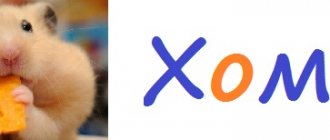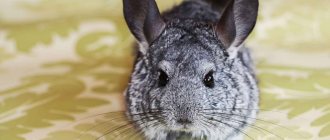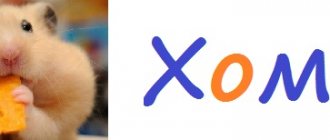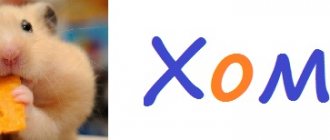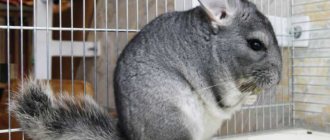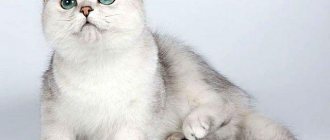Information / Behavior of chinchillas at home
The usual behavior of chinchillas at home is calm and friendly. The animal sleeps during the day, feeds and is active in the evening and at night. In a cage, a chinchilla spends most of its time on the top shelf. The animal sleeps sitting or in funny positions on its side. Chinchillas are active, at night they start a merry run around in the cage. The animals occasionally make sounds. You are probably familiar with the behavior of cats and dogs. It is very varied and informative, but chinchillas show emotions in their own way and show affection for humans. However, the conversation will not be about cuteness, but about the practical side of studying behavior. Let's try to understand by activity, behavior and emotions whether the chinchilla feels good or bad.
Historical facts about the origin of the chinchilla
Where exactly and from what animal chinchillas began their own origin is unknown. During excavations in the Cordillera, archaeologists discovered the ossified remains of the most ancient likenesses of animal species. Based on the type of genetic structure, they resembled the modern chinchilla. It should be noted that the prehistoric type of this animal was large in size.
In accordance with a rough estimate, the oldest animal, to which the found remains belong, lived about fifty years ago, therefore, the chronological information of these animals contains more than a thousand years.
The first literary mentions of the chinchilla family date back to the mid-sixteenth century. Fluffy lumps were mentioned in the work of a Spanish historian who sailed to South America with the conquistadors.
Genomic features
Connoisseurs of black animals affectionately call them “a touch of velvet” or “black velvet.” The black chinchilla, the characteristics of the genotype of which have already been sufficiently studied, has some genetic characteristics. This color is considered heterozygous, that is, two genes are present in one allele - dominant (black) and recessive.
Read also: Instagram story size in pixels
Black chinchillas have one negative feature - their color contains the so-called “lethal gene”. This leads to the fact that as a result of crossing two chinchillas with a black gene, the embryos either die during development or do not develop at all.
Outlining external data
Based on their appearance, chinchillas resemble large squirrels, and based on the way they move, they resemble bunnies. Fluffy animals have thick, thick and delicate fur, large dark eyes and large ears. It is with the help of the ears that chinchillas can reduce the overall temperature of the body, due to the fact that they have a dense capillary network.
The pet's body reaches 40 cm, and the tail - 15 cm. The forelimbs are shorter than the hind limbs, as a result of which their movement resembles hare jumps. Chinchillas have four toes on their hind legs and five on their front legs. With the help of their front paws, animals can carry out grasping movements.
A chinchilla has 20 teeth in its mouth; they grow throughout its entire life. Therefore, it is essential for an animal to be able to chew something.
Temperature
This is the most important point, so I made it separately. Comfortable temperature for a chinchilla is +14…20 °C. If the house is hotter than +25 °C, the pet may get heatstroke and die. In addition, a chinchilla can overheat if it runs around the house or in a wheel for a long time.
How to help a chinchilla cope with the heat?
Only temporary measures are described here - they will help when you urgently need to cool your pet:
- Place granite, ceramic or marble tiles on the bottom of the cage. First you need to wash it well and then keep it in the freezer.
- At night, cover the cage with a blanket and open the windows in the room.
- You can reduce the temperature with ice-cold water bottles - place a couple of them next to the cage or on top. Bottles should be wrapped in towels to prevent excess moisture.
- Your pet's ears and paws can be wiped with a cloth moistened with cold water.
- Place the chinchilla's bathing suit in the refrigerator for 15 minutes and then place it in the cage.
- Make your own mini air conditioner.
How did chinchillas become domesticated?
Due to the fact that the number of furry animals has decreased significantly due to continuous fishing, a number of efforts have been made to domesticate this animal. Man did not have a single concept about animals. Not a single scientist could find out in what environment it should be, how proper feeding is carried out, therefore, all efforts and their reproduction in limited areas ended in failure.
In the 20s of the nineteenth century, the dream of a huge number of people on the planet about chinchilla farms became a reality thanks to Matthias Chapman. A mining engineer by qualification, Matias worked in Chilean mines and had close ties with the indigenous people inhabiting those lands.
One of them came to the man and offered to buy an unknown animal; the enthusiastic engineer bought the baby. He kept a new favorite under observation and thought about being able to deliver a number of similar animals to America and thoroughly begin breeding them. Having paid several Indians as guides and furball catchers, the man headed for the mountains. Having caught about 10 adult chinchillas, four of which turned out to be females, he returned from the USA. During the trip, one chinchilla gave birth to a litter of two rodents, but only one could survive.
It was this group of the chinchilla family that became the first animals that were able to bring a brood in a limited area, thereby the man laid the foundation for the domestication of individuals.
Fifty years later, there were several thousand chinchilla farms in America and neighboring Canada. Despite the fact that the animals were mainly bred only for their fur, quite a large number of breeders began to sell them as pets. One way or another, it was a profitable business; the price for one rodent could reach up to $200.
Currently, breeding is carried out throughout Europe, new unusual colors of fluffies are being acquired in connection with breeding work.
Basic care: feeding, bathing and cleaning the cage
Feeding
The main component of home care for a chinchilla is feeding. Shusha is a herbivore. In the wild, its diet consists of dry grass and tree bark. In captivity, food includes 4 components:
- main food, it should make up 70-80% of the diet
- cereals
- hay
- complementary foods (treats) - no more than 10%.
The animal needs bottled or boiled water. Tap water cannot be given.
Chinchillas should not be given anything raw. Allowed berries, fruits, branches and leaves must be well dried.
Choosing the main food
Proper basic food is the key to good health for your pet. The main rule of good food is that it should consist entirely of compressed grass pellets. It should not contain any additives, including approved complementary foods and colored granules.
High-quality granules can be ordered from farmers and professional breeders. It can also be purchased at a pet store. Pay attention to the products of the following companies:
- Vitakraft,
- Versele-Laga,
- JR Farm,
- Benelux,
- Beaphar.
Carefully study the composition of the feed. The presence of salt, yeast and preservatives is not allowed (see what to feed a chinchilla). An adult needs 2 tbsp. feed per day. All uneaten food should be removed and replaced with fresh food.
How to accustom a chinchilla to the right food?
Many people buy chinchillas that have been trained to eat improperly. Moving is very stressful, so it is not recommended to suddenly change the animal’s diet. It is advisable to ask the seller for some of the food that the animal was fed with or to find out in detail about its usual diet.
Start small:
- Eliminate all fresh foods immediately.
- Use the correct food as a base and mix in 1/3 of the normal food.
- Over the course of a week, gradually reduce the amount of your usual food, replacing it with a new one. If you notice that your animal is not eating well, increase the amount of sweets. This process may take a month.
Add grains and hay
Cereals also make up the daily diet. Every day, give 1 teaspoon of rolled oats, buckwheat, corn, lentils or a mixture of 5 grains. Shushis are very fond of flax seed, but you can give it a little at a time (no more than 1/3 tsp).
Hay should be given once every 3-4 days in small portions. It is better to put it in a hanging hay. Fallen hay needs to be picked up. Firstly, dirty hay can harm the bush, and secondly, it causes a strong unpleasant odor. Also make sure that purchased hay is free of roots and soil.
Lure
Many people underestimate the importance of complementary foods and consider them just ordinary treats. In fact, the right treats are an excellent source of nutrients. If they are varied, you don’t have to worry about the quality of your pet’s fur and teeth.
How to pamper your pet? You can buy ready-made complementary food for chinchillas. Many feed manufacturers have it. Such a delicacy should make up no more than 10% of the total diet, that is, approximately 1/3 tsp.
If you wish, you can make the goodies yourself. Simply collect and dry berries, fruits or branches. Remember that herbs can only be collected in ecologically clean areas away from the highways.
Chinchillas can:
- branches, leaves and berries of hawthorn, viburnum, cranberry, gooseberry, sea buckthorn, rowan, currant, bearberry, blueberry,
- lingonberry leaves and berries,
- blackberry leaves and stems,
- blue honeysuckle berries,
- strawberry and raspberry leaves and fruits,
- branches, leaves and fruits of viburnum,
- juniper berries,
- mulberry branches and leaves,
- rosehip fruits and flowers,
- calamus root, ginseng and burdock,
- carrot,
- Bell pepper,
- greens and parsley root,
- Jerusalem artichoke root and stems,
- bird knotweed stems,
- leaves, inflorescences and stems of oregano,
- jasmine flowers,
- leaves, stems and flowers of fireweed,
- calendula flowers,
- hibiscus,
- sorrel,
- clover stems,
- nettle,
- alfalfa,
- mallow leaves,
- leaves and stems of the common cuff,
- leaves, stems and flowers of goat's rue,
- coltsfoot leaves,
- lemon balm,
- mint (great for stress relief!),
- dandelion root and leaves,
- plantain,
- rose buds,
- chamomile,
- chicory root, stems and flowers,
- thyme stems and strings,
- echinacea leaves,
- branches of acacia, maple,
- branches and leaves of birch, elm, pear, willow, linden, hazel, aspen, poplar, alder, ash,
- branches, leaves and buds of willow,
- branches, leaves, fruits and inflorescences of an apple tree,
- pumpkin seeds,
- spikelets and stems of brome, fragrant spikelet, meadow bluegrass, red fescue, wheatgrass, ryegrass, shaker grass,
- grape leaves and vines,
- green tea leaves.
Prepare 7-10 options and alternate them regularly. This way the animal will receive all the necessary vitamins and nutrients.
Do not overfeed your animal with sweets! The chinchilla liver is not designed to process large amounts of glucose. Poor nutrition will greatly shorten their lifespan. On average, a rodent with an improper diet lives up to 3-4 years and gets sick regularly.
Fur care
Chinchillas have soft fur that covers their entire body. In order for it to remain beautiful, it needs to be looked after regularly. They love to take care of themselves. They bathe and groom their fur regularly, but need a little help.
Once a week the animal needs to be bathed in the sand. Buy special sand for chinchillas or volcanic dust (it will give the fur a special shine). Pour it into a special bathing suit, which often comes with the cage. You can make your own bathing suit from a 5-liter bottle or wood. Open it and give it, the zeyer will happily brush his fur coat, happily tossing and turning in the sand.
Do not leave the bathing suit on for more than 30 minutes. Chinchillas love to sleep in it, and prolonged contact with sand dries out the skin. Also, there is no need to succumb to persuasion and put on a bathing suit more than once every 4 days.
It is contraindicated to wet the fur. It takes a long time to dry, and Shusha can catch a cold. In addition, during bathing, water can get into the ears, which will result in an inflammatory process. If the fur is very dirty, use a damp towel and a fine-toothed comb to gently remove dirt.
Cleaning tips
The cage requires major cleaning every 3-4 days. It doesn't take long to clean up. To speed up this process, use a small dustpan and brush.
Use any unscented wood filler. There are special litters for rodents, but cat litters are also suitable.
It is prohibited to use the following as bedding:
- sawdust (they are too small and can get into the chinchilla’s eyes),
- newspapers (paint contains toxic lead),
- rags (shusha will eat threads).
Do chinchillas have intelligence?
Experts confidently call the soft lump an intelligent and quick-witted creature. Quite a large number of chinchillas can manipulate the owner themselves, in order to beg for a treat or to take a walk outside the cage.
Cunning pets use something that the owner cannot resist. This is an offended little face, which he eagerly rushes to please with a delicious treat or get out of the cage. Understanding this hobby of the owner, the chinchilla can put on a deliberately unhappy and distressed expression on his face to achieve his own goals.
Contact with other animals
Chinchillas interact with other pets in different ways:
- Rodents: quickly find mutual understanding with guinea pigs and hamsters;
- cats: they remain coldly indifferent to them, and at the stage of getting used to the neighborhood, conflicts are possible;
- dogs: relations here are warmer. However, you should not leave puppies and growing chinchillas together;
- snakes, lizards, spiders and other living creatures: it is better not to let the animal near the terrarium with enemies and dangerous insects.
It is easy to find a language with a chinchilla by studying its character and habits. It can brighten up leisure time and dispel sadness. A flock of chinchillas will bring a lot of positive moments into life.
Characteristic traits of character and habits
Each chinchilla has its own character and habits; even animals from the same litter do not have the slightest unity. Just like humans, animals have 4 character types.
Choleric
This is a nimble, agile and active animal. During the daytime he dozes forward, however, his sleep is light, and he can wake up from the slightest rustle. During the period of activity, the pet, with inquisitive behavior, studies the objects around it and everything that interests it. Cholerics are quite timid, and, if frightened, the animal will rush around a limited area, demolishing everything that comes across on the road.
Sanguine
A chinchilla that has this type of character is also active and curious, but is less timid and can react calmly to loud sounds and rustles. The animal does not like to be in one position for a long period of time; it walks around the premises with interest with the permission of the owner.
Phlegmatic person
The phlegmatic chinchilla is a calm and balanced pet. Throughout the day she stays in her own home, replacing active games with sweet sleep. Even when awake, the phlegmatic animal moves measuredly, with some laziness.
Behavioral Signs of Stress
Chinchillas are susceptible to stress, which occurs under the influence of external or internal causes. Signs of stress in an animal include decreased appetite, decreased motor activity, avoidance of humans, and gnawing of fur. Learn more about stress factors and fur chewing >>> . Identify and eliminate stressors.
It happens that a wild chinchilla is not easy to handle; it will not bite or shoot urine, but will shed its fur. When you grab the animal, the fur will fall out at the point of contact with your hand. This is their protective natural instinct of “freeing themselves from the clutches of a predator.” Don't worry, the fur will grow back quickly. Try not to grab the chinchilla too harshly, especially not with a sudden movement from above.
